The recent attacks in Dallas, Nice, Baton Rouge and Wurzburg have again raised public awareness of lone attackers unaffiliated with an organized terrorist group. I am constantly asked how governments can defend against this new threat. But the question is misguided: Lone attackers operating under a model of leaderless resistance is not a new phenomenon. Stratfor has been tracking the devolution of the jihadist movement from a hierarchical structure to a more grassroots one for more than a decade. Though leaderless resistance is by design more difficult for authorities to detect and deter, those who practice it are still bound by the vulnerabilities in the terrorist attack-planning cycle. ...


